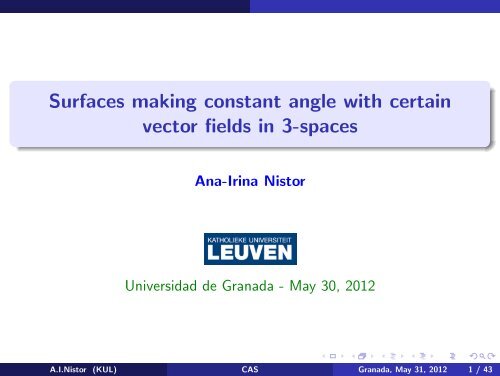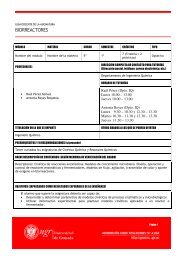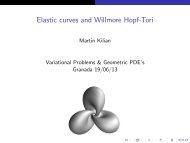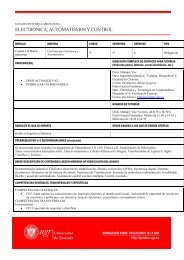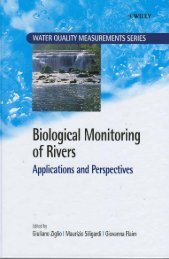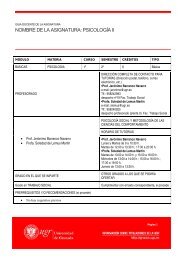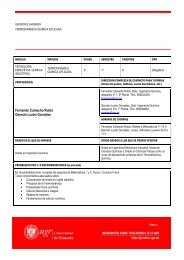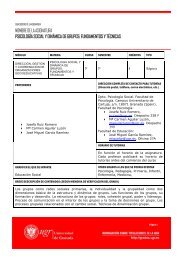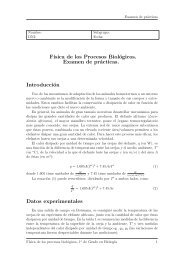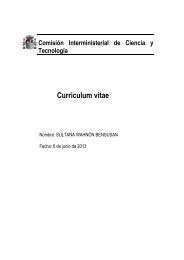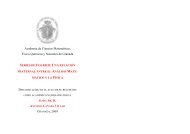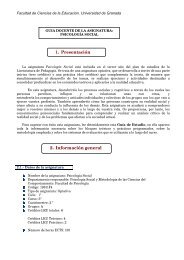Surfaces making constant angle with certain vector fields in 3-spaces
Surfaces making constant angle with certain vector fields in 3-spaces
Surfaces making constant angle with certain vector fields in 3-spaces
- No tags were found...
You also want an ePaper? Increase the reach of your titles
YUMPU automatically turns print PDFs into web optimized ePapers that Google loves.
<strong>Surfaces</strong> <strong>mak<strong>in</strong>g</strong> <strong>constant</strong> <strong>angle</strong> <strong>with</strong> <strong>certa<strong>in</strong></strong><strong>vector</strong> <strong>fields</strong> <strong>in</strong> 3-<strong>spaces</strong>Ana-Ir<strong>in</strong>a NistorUniversidad de Granada - May 30, 2012A.I.Nistor (KUL) CAS Granada, May 31, 2012 1 / 43
Outl<strong>in</strong>eOutl<strong>in</strong>e1 Introduction2 Constant <strong>angle</strong> <strong>with</strong> R direction <strong>in</strong> Product SpacesCAS <strong>in</strong> M 2 × RCPD <strong>in</strong> M 2 × RCAS&CPD <strong>in</strong> Lorentzian Product <strong>spaces</strong> M 2 × R 13 Constant <strong>angle</strong> <strong>with</strong> the position <strong>vector</strong>Constant slope surfaces <strong>in</strong> E 34 Constant <strong>angle</strong> <strong>with</strong> a Kill<strong>in</strong>g <strong>vector</strong> field <strong>in</strong> E 35 CAS <strong>in</strong> Heisenberg group6 CAS <strong>in</strong> Solvable Lie groupsA.I.Nistor (KUL) CAS Granada, May 31, 2012 2 / 43
IntroductionConstant Angle <strong>Surfaces</strong>A <strong>constant</strong> <strong>angle</strong> surface (CAS <strong>in</strong> short) is an oriented surface for whichits normal makes a <strong>constant</strong> <strong>angle</strong> <strong>with</strong> a fixed direction, which is chosen<strong>in</strong> each case as a preferred direction <strong>in</strong> the ambient space:1 R direction <strong>in</strong> M 2 × R, M 2 × R 12 position <strong>vector</strong> <strong>in</strong> E 3 and E 3 13 Kill<strong>in</strong>g <strong>vector</strong> field <strong>in</strong> E 34 Kill<strong>in</strong>g <strong>vector</strong> field e 3 = ∂ z <strong>in</strong> Nil 35 left <strong>in</strong>variant <strong>vector</strong> field <strong>in</strong> G(µ 1 , µ 2 ), <strong>in</strong> particular <strong>in</strong>Sol 3 = G(−1, 1)A.I.Nistor (KUL) CAS Granada, May 31, 2012 3 / 43
IntroductionConstant Angle <strong>Surfaces</strong> and Pr<strong>in</strong>cipal DirectionsA property of CAS:When the ambient is of the form M 2 × R, a favored direction is R. It isknown that for a <strong>constant</strong> <strong>angle</strong> surface <strong>in</strong> E 3 , S 2 × R or <strong>in</strong> H 2 × R, theprojection of ∂ ∂t(where t is the global parameter on R) onto the tangentplane of the immersed surface, denoted by T , is a pr<strong>in</strong>cipal direction 1 <strong>with</strong>the correspond<strong>in</strong>g pr<strong>in</strong>cipal curvature 2 identically zero.Study surfaces endowed <strong>with</strong> a pr<strong>in</strong>cipal direction T which will be called acanonical pr<strong>in</strong>cipal direction (CPD <strong>in</strong> short).1 eigen<strong>vector</strong> of the shape operator2 eigenvalue of the shape operatorA.I.Nistor (KUL) CAS Granada, May 31, 2012 3 / 43
Constant <strong>angle</strong> <strong>with</strong> R direction <strong>in</strong> Product SpacesResults - CAS <strong>in</strong> M 2 × RCAS <strong>in</strong> M 2 × RF. Dillen, J. Fastenakels, J. Van der Veken, L. Vrancken, Constant<strong>angle</strong> suraces <strong>in</strong> S 2 × R, Monatsh. Math. 152 (2)(2007), 89–96.F. Dillen, M.I. Munteanu, Constant Angle <strong>Surfaces</strong> <strong>in</strong> H 2 × R, Bull.Braz. Math. Soc. 40 (1) (2009) 1, 85–97.M.I. Munteanu, N., A new approach on <strong>constant</strong> <strong>angle</strong> surfaces <strong>in</strong> E 3 ,Turkish J. Math. 33 (2) (2009), 169–178.A.I.Nistor (KUL) CAS Granada, May 31, 2012 4 / 43
Constant <strong>angle</strong> <strong>with</strong> R direction <strong>in</strong> Product SpacesResults - CPD <strong>in</strong> M 2 × RCPD <strong>in</strong> M 2 × RF. Dillen, J. Fastenakels, J. Van der Veken, <strong>Surfaces</strong> <strong>in</strong> S 2 × R <strong>with</strong> acanonical pr<strong>in</strong>cipal direction, Ann. Glob. Anal. Geom., 35(2009) 4,381–396.F. Dillen, M.I. Munteanu, N., <strong>Surfaces</strong> <strong>in</strong> H 2 × R <strong>with</strong> a canonicalpr<strong>in</strong>cipal direction, Taiwanese J. Math., 15 (2011) 5, 2265-2289.M.I. Munteanu, N., Complete classification of surfaces <strong>with</strong> acanonical pr<strong>in</strong>cipal direction <strong>in</strong> the Euclidean space E 3 , Cent. Eur. J.Math., 9(2011)2, 378–389.A.I.Nistor (KUL) CAS Granada, May 31, 2012 5 / 43
Constant <strong>angle</strong> <strong>with</strong> R direction <strong>in</strong> Product Spaces CAS&CPD <strong>in</strong> Lorentzian Product <strong>spaces</strong> M 2 × R 1CAS&CPD <strong>in</strong> M 2 × R 1 - Prelim<strong>in</strong>aries• M 2 × R 1 the product of M 2 (c) - a 2-dimensional space form of <strong>constant</strong>sectional curvature c and R 1• 〈 , 〉 = 〈 , 〉 M 2 − dt 2 - the Lorentzian metric• the surface M is given by L : M → M 2 × R 1• ξ is a δ-unit normal <strong>vector</strong> field to M, 〈ξ, ξ〉 = δ ∈ {−1, 1}.δ = −1, ξ is timelike iff M is spacelikeδ = 1, ξ is spacelike iff M is timelike• ∂ t := (∂/∂t), t ∈ R 1 is a unitary timelike <strong>vector</strong> field on M 2 × R 1 ,∂ t = T + ΘξΘ = cosh θ (M is spacelike) or Θ = s<strong>in</strong>h θ (M is timelike).• for every tangent <strong>vector</strong> field X on M:∇ X T = ΘSX , (1)X (Θ) = −δ〈SX , T 〉. (2)A.I.Nistor (KUL) CAS Granada, May 31, 2012 6 / 43
Constant <strong>angle</strong> <strong>with</strong> R direction <strong>in</strong> Product Spaces CAS&CPD <strong>in</strong> Lorentzian Product <strong>spaces</strong> M 2 × R 1Prelim<strong>in</strong>aries - more about <strong>angle</strong>sRecall that ∂ t is timelike <strong>in</strong> (M 2 × R 1 , 〈 , 〉).If M is a spacelike surface, then ξ is timelike, and we will consider it <strong>with</strong>the same time-orientation as ∂ t , i.e. future-directed, 〈∂ t , ξ〉 < 0.• The <strong>angle</strong> θ between two unitary timelike <strong>vector</strong>s was def<strong>in</strong>ed for thefirst time <strong>in</strong> 1984, as:cosh θ = −〈∂ t , ξ〉.If M is a timelike surface, then ξ is spacelike.• The <strong>angle</strong> θ between a timelike and a spacelike unitary <strong>vector</strong>s wasdef<strong>in</strong>ed for the first time <strong>in</strong> 2005, as:s<strong>in</strong>h θ = 〈∂ t , ξ〉.G. Birman, K. Nomizu, Trigonometry <strong>in</strong> Lorentzian geometry, Amer.Math. Monthly, 91(1984)9, 543–549.E. Ne˘sović, M.Petrović - Torga˘sev, L. Verstraelen, Curves <strong>in</strong> Lorentzian<strong>spaces</strong>, Boll. Unione Mat. Ital., serie 8, 8-B(2005)3, 685–696.A.I.Nistor (KUL) CAS Granada, May 31, 2012 7 / 43
Constant <strong>angle</strong> <strong>with</strong> R direction <strong>in</strong> Product Spaces CAS&CPD <strong>in</strong> Lorentzian Product <strong>spaces</strong> M 2 × R 1Spacelike surfaces <strong>in</strong> S 2 × R 1 and H 2 × R 1• <strong>constant</strong> <strong>angle</strong> spacelike surfaces <strong>in</strong> M<strong>in</strong>kowski 3−space (when c = 0)have been classified <strong>in</strong>R. López, M.I. Munteanu, Constant <strong>angle</strong> surfaces <strong>in</strong> M<strong>in</strong>kowskispace, Bull. Belg. Math. Soc. - Simon Stev<strong>in</strong> , 18 (2011) 2, 271–286.• we extend this study to <strong>constant</strong> <strong>angle</strong> spacelike surfaces <strong>in</strong> S 2 × R 1(c = 1) and H 2 × R 1 (c = −1) .• we study canonical pr<strong>in</strong>cipal directions for spacelike surfaces <strong>in</strong> theambient space M 2 × R 1 .A.I.Nistor (KUL) CAS Granada, May 31, 2012 8 / 43
Constant <strong>angle</strong> <strong>with</strong> R direction <strong>in</strong> Product Spaces CAS&CPD <strong>in</strong> Lorentzian Product <strong>spaces</strong> M 2 × R 1Spacelike surfaces <strong>in</strong> S 2 × R 1 and H 2 × R 1Theorem (Fu, N.)Let M be a spacelike surface immersed <strong>in</strong>to Lorentzian product spaceM 2 (c) × R 1 , <strong>with</strong> c = −1, 1. Then, M is a <strong>constant</strong> <strong>angle</strong> spacelike surfaceif and only if the immersion L is locally given by:(a) If c = 1, then L : M → S 2 × R 1 ↩→ R 4 1 ,L(u, v) = ( cos(u cosh θ)f (v) + s<strong>in</strong>(u cosh θ)f (v) × f ′ (v), −u s<strong>in</strong>h θ ) ,where f is a unit speed curve <strong>in</strong> S 2 .(b) If c = −1, then L : M → H 2 × R 1 ↩→ R 4 2 ,L(u, v) = ( cosh(u cosh θ)f (v)+s<strong>in</strong>h(u cosh θ)f (v)⊠f ′ (v), −u s<strong>in</strong>h θ ) ,where f is a unit speed curve <strong>in</strong> H 2 .In both cases θ ≠ 0 denotes the <strong>constant</strong> hyperbolic <strong>angle</strong>.If θ = 0, then ∂ t is a normal <strong>vector</strong> field and M is an open part of thespacelike surface: • S 2 × {t 0 } for c = 1• H 2 × {t 0 } for c = −1.A.I.Nistor (KUL) CAS Granada, May 31, 2012 9 / 43
Constant <strong>angle</strong> <strong>with</strong> R direction <strong>in</strong> Product Spaces CAS&CPD <strong>in</strong> Lorentzian Product <strong>spaces</strong> M 2 × R 1Spacelike surfaces <strong>in</strong> S 2 × R 1 and H 2 × R 1Theorem (Fu, N.)Let L : M → M 2 (c) × R 1 , c = −1, 1 be a spacelike surface and let θ be thehyperbolic <strong>angle</strong> function. Then, T is a canonical pr<strong>in</strong>cipal direction for Mif and only if M is parameterized as:(a) If c = 1, then(L : M → S 2 × R 1 ↩→ R 4 1 , )L(u, v) = cos φ(u) f (v) + s<strong>in</strong> φ(u) N f (v), χ(u) , where f is aregular curve on S 2 and N f (v) =f (v)×f ′ (v)√〈f ′ (v),f ′ (v)〉is the normal of f .(b) If c = −1,(then L : M → H 2 × R 1 ↩→ R 4 2 , )L(u, v) = cosh φ(u) f (v) + s<strong>in</strong>h φ(u) N f (v), χ(u) , where f is aregular curve on H 2 and N f (v) =f (v)⊠f ′ (v)√〈f ′ (v),f ′ (v)〉is the normal of f .Moreover, φ(u) =∫ ucosh θ(τ)dτ and χ(u) = −∫ us<strong>in</strong>h θ(τ)dτ.A.I.Nistor (KUL) CAS Granada, May 31, 2012 10 / 43
Constant <strong>angle</strong> <strong>with</strong> R direction <strong>in</strong> Product Spaces CAS&CPD <strong>in</strong> Lorentzian Product <strong>spaces</strong> M 2 × R 1CPD for spacelike surfaces <strong>in</strong> E 3 1Theorem (N.)Let L : M → E 3 1 be a spacelike surface isometrically immersed <strong>in</strong> E3 1 andlet θ(p) ≠ 0 be the hyperbolic <strong>angle</strong> function. Then, M has a canonicalpr<strong>in</strong>cipal direction if and only if M is parametrized by:(c.1) L(u, v) =∫( ) ucos v, s<strong>in</strong> v, 0 cosh θ(τ)dτ − ( 0, 0, 1 ) ∫ us<strong>in</strong>h θ(τ)dτ + γ(v),where ( ∫ ∫γ(v) = ψ(v) s<strong>in</strong> v dv, −)ψ(v) cos v dv, 0 , ψ ∈ C ∞ (M),(c.2) L(u, v) =(cos v0 , s<strong>in</strong> v 0 , 0 ) ∫ ucosh θ(τ)dτ − ( 0, 0, 1 ) ∫ us<strong>in</strong>h θ(τ)dτ + vγ 0 ,()where γ 0 = − s<strong>in</strong> v 0 , cos v 0 , 0 , and v 0 is a real <strong>constant</strong>.A.I.Nistor (KUL) CAS Granada, May 31, 2012 11 / 43
Constant <strong>angle</strong> <strong>with</strong> R direction <strong>in</strong> Product Spaces CAS&CPD <strong>in</strong> Lorentzian Product <strong>spaces</strong> M 2 × R 1CPD for spacelike surfaces <strong>in</strong> E 3 1 <strong>with</strong> H = 0Theorem (N.)The only maximal spacelike surfaces <strong>in</strong> E 3 1 <strong>with</strong> a canonical pr<strong>in</strong>cipal directionare the catenoids of 1st k<strong>in</strong>d, L : M → E 3 1 ,(√L(u, v) = u 2 − m 2 cos v, √ u 2 − m 2 s<strong>in</strong> v, m ln(u + √ )u 2 − m 2 ) ,m ∈ R ∗ .RemarkUnder the assumption of flatness, we obta<strong>in</strong> the generalized cyl<strong>in</strong>ders fromcase (c.2) of the classification theorem.A.I.Nistor (KUL) CAS Granada, May 31, 2012 12 / 43
Constant <strong>angle</strong> <strong>with</strong> R direction <strong>in</strong> Product Spaces CAS&CPD <strong>in</strong> Lorentzian Product <strong>spaces</strong> M 2 × R 1The catenoid of 1st k<strong>in</strong>dThe catenoid of 1st k<strong>in</strong>d maybe obta<strong>in</strong>ed rotat<strong>in</strong>g thecurve( ( t) )m s<strong>in</strong>hm − ln m , 0, taround the Oz axis.Figure: m = 1, t ∈ [−3, 3], v ∈ [0, 2π]A.I.Nistor (KUL) CAS Granada, May 31, 2012 13 / 43
Constant <strong>angle</strong> <strong>with</strong> R direction <strong>in</strong> Product Spaces CAS&CPD <strong>in</strong> Lorentzian Product <strong>spaces</strong> M 2 × R 1Timelike surfaces <strong>in</strong> S 2 × R 1 and H 2 × R 1• <strong>constant</strong> <strong>angle</strong> timelike surfaces <strong>in</strong> M<strong>in</strong>kowski 3−space (when c = 0)have been classified <strong>in</strong>F. Güler, G. Şaffak, E. Kasap, Timelike <strong>constant</strong> <strong>angle</strong> surfaces <strong>in</strong>M<strong>in</strong>kowski space R 3 1 , Int. J. Contemp. Math. Sci., 6(2011)44,2189–2200.• we study <strong>constant</strong> <strong>angle</strong> timelike surfaces <strong>in</strong> S 2 × R 1 (c = 1) andH 2 × R 1 (c = −1) .• we study canonical pr<strong>in</strong>cipal directions for timelike surfaces <strong>in</strong> theambient space M 2 × R 1 .A.I.Nistor (KUL) CAS Granada, May 31, 2012 14 / 43
Constant <strong>angle</strong> <strong>with</strong> R direction <strong>in</strong> Product Spaces CAS&CPD <strong>in</strong> Lorentzian Product <strong>spaces</strong> M 2 × R 1Timelike CAS S 2 × R 1 and H 2 × R 1Theorem (Fu, N.)Let L : M → M 2 (c) × R 1 be a timelike surface immersed <strong>in</strong>to Lorentzianproduct space M 2 (c) × R 1 . Then M is a <strong>constant</strong> <strong>angle</strong> timelike surface ifand only if the immersion L is locally given by:(a) If c = 1, then L : M → S 2 × R 1 ,L(u, v) = ( cos(u s<strong>in</strong>h θ)f (v) + s<strong>in</strong>(u s<strong>in</strong>h θ)f (v) × f ′ (v), u cosh θ ) ,where f is a unit speed curve <strong>in</strong> S 2 ,(b) If c = −1, then L : M → H 2 × R 1 ,L(u, v) = ( cosh(u s<strong>in</strong>h θ)f (v) + s<strong>in</strong>h(u s<strong>in</strong>h θ)f (v) ⊠ f ′ (v), u cosh θ ) ,where f is a unit speed curve <strong>in</strong> H 2 .In both cases θ ≠ 0 denotes the <strong>constant</strong> hyperbolic <strong>angle</strong>.If θ = 0, then ∂ t is a tangent <strong>vector</strong> field, has no normal component, andM is an open part of γ × R 1 , where γ ∈ M 2 (c), c ∈ {−1, 1}.A.I.Nistor (KUL) CAS Granada, May 31, 2012 15 / 43
Constant <strong>angle</strong> <strong>with</strong> R direction <strong>in</strong> Product Spaces CAS&CPD <strong>in</strong> Lorentzian Product <strong>spaces</strong> M 2 × R 1CPD for timelike surfaces <strong>in</strong> M 2 × R 1Theorem (Fu, N.)Let L : M → M 2 (c) × R 1 be a timelike surface and let θ be the hyperbolic<strong>angle</strong> function. Then, T is a canonical pr<strong>in</strong>cipal direction for M if and onlyif M is parametrized as:(a) If c = 1, then ( L : M → S 2 × R 1 ,)L(u, v) = cos χ(u) f (v) + s<strong>in</strong> χ(u) N f (v), φ(u) , where f is aregular curve on S 2 and N f (v) =f (v)×f ′ (v)√〈f ′ (v),f ′ (v)〉is the normal of f .(b) If c = −1, ( then L : M → H 2 × R 1 ,)L(u, v) = cosh χ(u) f (v) + s<strong>in</strong>h χ(u) N f (v), φ(u) , where f is aregular curve on H 2 and N f (v) =f (v)⊠f ′ (v)√〈f ′ (v),f ′ (v)〉is the normal of f .Moreover, φ(u) =∫ ucosh θ(τ)dτ and χ(u) =∫ us<strong>in</strong>h θ(τ)dτ.A.I.Nistor (KUL) CAS Granada, May 31, 2012 16 / 43
Constant <strong>angle</strong> <strong>with</strong> R direction <strong>in</strong> Product Spaces CAS&CPD <strong>in</strong> Lorentzian Product <strong>spaces</strong> M 2 × R 1CPD for timelike surfaces <strong>in</strong> M 2 × R 1Theorem (Fu, N.)Let L : M → M 2 (c) × R 1 be a timelike surface and let θ be the hyperbolic<strong>angle</strong> function. Then, T is a canonical pr<strong>in</strong>cipal direction for M if and onlyif M is parametrized as:(c) If c = 0, then L : M → E 3 (1 ,)(c.1) L(u, v) = χ(u) cos v, χ(u) s<strong>in</strong> v, φ(u) + γ(v),( ∫∫)where γ(v) = − ψ(v) s<strong>in</strong> v dv, ψ(v) cos v dv, 0 ,and ψ is a(smooth function,)(c.2) L(u, v) = χ(u) cos v 0 , χ(u) s<strong>in</strong> v 0 , φ(u) + γ 0 v,where γ 0 = ( − s<strong>in</strong> v 0 , cos v 0 , 0 ) , and v 0 is a real <strong>constant</strong>.Moreover, φ(u) =∫ ucosh θ(τ)dτ and χ(u) =∫ us<strong>in</strong>h θ(τ)dτ.A.I.Nistor (KUL) CAS Granada, May 31, 2012 16 / 43
Constant <strong>angle</strong> <strong>with</strong> R direction <strong>in</strong> Product Spaces CAS&CPD <strong>in</strong> Lorentzian Product <strong>spaces</strong> M 2 × R 1CPD for timelike surfaces <strong>in</strong> E 3 1 - m<strong>in</strong>imalityCorollary (Fu, N.)The only flat timelike surfaces M immersed <strong>in</strong> E 3 1 endowed <strong>with</strong> a canonicalpr<strong>in</strong>cipal direction are given by the cyl<strong>in</strong>drical surfaces parametrized <strong>in</strong> case(c.2) of previous Theorem.Theorem (Fu, N.)The only m<strong>in</strong>imal timelike surfaces M immersed <strong>in</strong> E 3 1 endowed <strong>with</strong> acanonical pr<strong>in</strong>cipal direction are given by the catenoids of 3rd k<strong>in</strong>d parametrizedas:L(t, v) =(m cos t m cos v, m cos t )m s<strong>in</strong> v, t , m ∈ R ∗ .A.I.Nistor (KUL) CAS Granada, May 31, 2012 17 / 43
Constant <strong>angle</strong> <strong>with</strong> R direction <strong>in</strong> Product Spaces CAS&CPD <strong>in</strong> Lorentzian Product <strong>spaces</strong> M 2 × R 1The catenoid of 3rd k<strong>in</strong>d...... may be obta<strong>in</strong>ed rotat<strong>in</strong>g thecurve:(m cos t m , 0, t ), m ∈ R ∗ ,around the Oz axis.Figure: m = 1, t ∈ [0, 2π], v ∈ [0, 2π]A.I.Nistor (KUL) CAS Granada, May 31, 2012 18 / 43
Constant <strong>angle</strong> <strong>with</strong> R direction <strong>in</strong> Product Spaces CAS&CPD <strong>in</strong> Lorentzian Product <strong>spaces</strong> M 2 × R 1Prepr<strong>in</strong>tsThe problems of- CAS for spacelike and timelike surfaces <strong>in</strong> S 2 × R 1 and H 2 × R 1- CPD for spacelike and timelike surfaces <strong>in</strong> M 2 × R 1are studied <strong>in</strong> :Y. Fu, N. Constant <strong>angle</strong> property and canonical pr<strong>in</strong>cipal directionsfor surfaces <strong>in</strong> M 2 (c) × R 1 , prepr<strong>in</strong>t 2012.- CPD for spacelike surfaces <strong>in</strong> E 3 1 :N., A note on spacelike surfaces <strong>in</strong> M<strong>in</strong>kowski 3-space, prepr<strong>in</strong>t 2011.A.I.Nistor (KUL) CAS Granada, May 31, 2012 19 / 43
Constant <strong>angle</strong> <strong>with</strong> the position <strong>vector</strong> Constant slope surfaces <strong>in</strong> E 3Constant <strong>angle</strong> <strong>with</strong> the position <strong>vector</strong>Logarithmic spirals =⇒ <strong>constant</strong> slope surfacesLogarithmic spiral: planar curve hav<strong>in</strong>g the property that the <strong>angle</strong> θbetween its tangent and the radial direction at every po<strong>in</strong>t is <strong>constant</strong>.A.I.Nistor (KUL) CAS Granada, May 31, 2012 20 / 43
Constant <strong>angle</strong> <strong>with</strong> the position <strong>vector</strong> Constant slope surfaces <strong>in</strong> E 3Constant <strong>angle</strong> <strong>with</strong> the position <strong>vector</strong>In other words, the logarithmic spiral is the curve whose tangent makes a<strong>constant</strong> <strong>angle</strong> θ <strong>with</strong> the position <strong>vector</strong> <strong>in</strong> every po<strong>in</strong>t.Question - surfaces:Pass<strong>in</strong>g from curves to surfaces, f<strong>in</strong>d all surfaces <strong>in</strong> the Euclidean3-space <strong>mak<strong>in</strong>g</strong> a <strong>constant</strong> <strong>angle</strong> <strong>with</strong> the position <strong>vector</strong>.A.I.Nistor (KUL) CAS Granada, May 31, 2012 20 / 43
Constant <strong>angle</strong> <strong>with</strong> the position <strong>vector</strong> Constant slope surfaces <strong>in</strong> E 3Constant <strong>angle</strong> <strong>with</strong> the position <strong>vector</strong>Answer: <strong>constant</strong> slope surfacesTheorem (Munteanu)Let r : M −→ E 3 be an isometric immersion. Then M is of <strong>constant</strong> slope ifand only if either it is an open part of the Euclidean 2-sphere centered<strong>in</strong> the orig<strong>in</strong>, or it can be parameterized byr(u, v) = u s<strong>in</strong> θ ( cos ϕ(u) f (v) + s<strong>in</strong> ϕ(u) f (v) × f ′ (v) )where θ is a <strong>constant</strong> (<strong>angle</strong>) different from 0, ϕ(u) = cot θ log u and f isa unit speed curve on the Euclidean sphere S 2 .θ = 0: the position <strong>vector</strong> is normal to the surface, M is an open partof the Euclidean 2-sphere;θ = π 2: M is a cone <strong>with</strong> the vertex <strong>in</strong> orig<strong>in</strong>, or a plane pass<strong>in</strong>gthrough orig<strong>in</strong>.A.I.Nistor (KUL) CAS Granada, May 31, 2012 20 / 43
ExamplesConstant <strong>angle</strong> <strong>with</strong> the position <strong>vector</strong> Constant slope surfaces <strong>in</strong> E 3θ = π 5θ = π 15f (v) = (cos v, s<strong>in</strong> v, 0) f (v) = (cos 2 v, cos v s<strong>in</strong> v, s<strong>in</strong> v)parametric l<strong>in</strong>es: blue: logarithmic spiralblack: the spherical curve f .A.I.Nistor (KUL) CAS Granada, May 31, 2012 21 / 43
Constant <strong>angle</strong> <strong>with</strong> the position <strong>vector</strong> Constant slope surfaces <strong>in</strong> E 3Constant slope surfacesM.I. Munteanu, From Golden Spirals to Constant Slope <strong>Surfaces</strong>, J.Math.Phys., 51 (2010) 7, 073507:1–9.Y. Fu, D. Yang, On <strong>constant</strong> slope spacelike surfaces <strong>in</strong> 3-dimensionalM<strong>in</strong>kowski space, J. Math. Analysis Appl., 385 (2012) 1, 208–220.Y. Fu, X. Wang, Classification of Timelike Constant Slope <strong>Surfaces</strong> <strong>in</strong>3-Dimensional M<strong>in</strong>kowski Space, Res. Math. 2012.A.I.Nistor (KUL) CAS Granada, May 31, 2012 22 / 43
Constant <strong>angle</strong> <strong>with</strong> a Kill<strong>in</strong>g <strong>vector</strong> field <strong>in</strong> E 3Prelim<strong>in</strong>ariesConstant <strong>angle</strong> <strong>with</strong> a Kill<strong>in</strong>g <strong>vector</strong> field -Prelim<strong>in</strong>aries• E 3 = (R 3 , 〈 , 〉),• ◦ ∇ - Levi-Civita connection correspond<strong>in</strong>g to 〈 , 〉 <strong>in</strong> E 3 ,• V is Kill<strong>in</strong>g iff it satisfies the Kill<strong>in</strong>g equation:for any <strong>vector</strong> <strong>fields</strong> X , Y <strong>in</strong> R 3 .• The set〈 ◦ ∇X V , Y 〉 + 〈 ◦ ∇Y V , X 〉 = 0,{∂ x , ∂ y , ∂ z , −y∂ x + x∂ y , z∂ y − y∂ z , z∂ x − x∂ z }gives a basis of Kill<strong>in</strong>g <strong>vector</strong> <strong>fields</strong> <strong>in</strong> E 3 .A.I.Nistor (KUL) CAS Granada, May 31, 2012 23 / 43
Constant <strong>angle</strong> <strong>with</strong> a Kill<strong>in</strong>g <strong>vector</strong> field <strong>in</strong> E 3Classification results for curvesCurves - <strong>constant</strong> <strong>angle</strong> <strong>with</strong> a Kill<strong>in</strong>g field• If ˜γ is a straight l<strong>in</strong>e, then γ is a helix.W.l.o.g. the l<strong>in</strong>e can be taken to be (parallel <strong>with</strong>) one of the coord<strong>in</strong>ateaxes, and this is an <strong>in</strong>tegral curve of a Kill<strong>in</strong>g <strong>vector</strong> <strong>vector</strong> field <strong>in</strong> E 3 .Motivated by this remark, a natural question appears:• which curves make a <strong>constant</strong> <strong>angle</strong> <strong>with</strong> a Kill<strong>in</strong>g <strong>vector</strong> field <strong>in</strong> E 3 ?A.I.Nistor (KUL) CAS Granada, May 31, 2012 24 / 43
Constant <strong>angle</strong> <strong>with</strong> a Kill<strong>in</strong>g <strong>vector</strong> field <strong>in</strong> E 3Classification results for curvesCurves - <strong>constant</strong> <strong>angle</strong> <strong>with</strong> a Kill<strong>in</strong>g field• If ˜γ is a straight l<strong>in</strong>e, then γ is a helix.W.l.o.g. the l<strong>in</strong>e can be taken to be (parallel <strong>with</strong>) one of the coord<strong>in</strong>ateaxes, and this is an <strong>in</strong>tegral curve of a Kill<strong>in</strong>g <strong>vector</strong> <strong>vector</strong> field <strong>in</strong> E 3 .Motivated by this remark, a natural question appears:• which curves make a <strong>constant</strong> <strong>angle</strong> <strong>with</strong> a Kill<strong>in</strong>g <strong>vector</strong> field <strong>in</strong> E 3 ?Recall that we have a basis of Kill<strong>in</strong>g <strong>vector</strong> <strong>fields</strong> <strong>in</strong> E 3 :{∂ x , ∂ y , ∂ z , −y∂ x + x∂ y , z∂ y − y∂ z , z∂ x − x∂ z }A.I.Nistor (KUL) CAS Granada, May 31, 2012 24 / 43
Constant <strong>angle</strong> <strong>with</strong> a Kill<strong>in</strong>g <strong>vector</strong> field <strong>in</strong> E 3Classification results for curvesCurves - <strong>constant</strong> <strong>angle</strong> <strong>with</strong> a Kill<strong>in</strong>g field• If ˜γ is a straight l<strong>in</strong>e, then γ is a helix.W.l.o.g. the l<strong>in</strong>e can be taken to be (parallel <strong>with</strong>) one of the coord<strong>in</strong>ateaxes, and this is an <strong>in</strong>tegral curve of a Kill<strong>in</strong>g <strong>vector</strong> <strong>vector</strong> field <strong>in</strong> E 3 .Motivated by this remark, a natural question appears:• which curves make a <strong>constant</strong> <strong>angle</strong> <strong>with</strong> a Kill<strong>in</strong>g <strong>vector</strong> field <strong>in</strong> E 3 ?Recall that we have a basis of Kill<strong>in</strong>g <strong>vector</strong> <strong>fields</strong> <strong>in</strong> E 3 :{∂ x , ∂ y , ∂ z , −y∂ x + x∂ y , z∂ y − y∂ z , z∂ x − x∂ z }A.I.Nistor (KUL) CAS Granada, May 31, 2012 24 / 43
Constant <strong>angle</strong> <strong>with</strong> a Kill<strong>in</strong>g <strong>vector</strong> field <strong>in</strong> E 3Classification results for curvesCurves - <strong>constant</strong> <strong>angle</strong> <strong>with</strong> a Kill<strong>in</strong>g field• If ˜γ is a straight l<strong>in</strong>e, then γ is a helix.W.l.o.g. the l<strong>in</strong>e can be taken to be (parallel <strong>with</strong>) one of the coord<strong>in</strong>ateaxes, and this is an <strong>in</strong>tegral curve of a Kill<strong>in</strong>g <strong>vector</strong> <strong>vector</strong> field <strong>in</strong> E 3 .Motivated by this remark, a natural question appears:• which curves make a <strong>constant</strong> <strong>angle</strong> <strong>with</strong> a Kill<strong>in</strong>g <strong>vector</strong> field <strong>in</strong> E 3 ?Recall that we have a basis of Kill<strong>in</strong>g <strong>vector</strong> <strong>fields</strong> <strong>in</strong> E 3 :{∂ x , ∂ y , ∂ z , −y∂ x + x∂ y , z∂ y − y∂ z , z∂ x − x∂ z }• which curves make a <strong>constant</strong> <strong>angle</strong> <strong>with</strong> V <strong>in</strong> E 3 ?A.I.Nistor (KUL) CAS Granada, May 31, 2012 24 / 43
Constant <strong>angle</strong> <strong>with</strong> a Kill<strong>in</strong>g <strong>vector</strong> field <strong>in</strong> E 3Classification results for curvesPlane curves - <strong>constant</strong> <strong>angle</strong> <strong>with</strong> VTheorem (Munteanu, N.)A curve <strong>in</strong> the xy-plane makes <strong>constant</strong> <strong>angle</strong> θ <strong>with</strong> the Kill<strong>in</strong>g <strong>vector</strong> fieldV = −y∂ x + x∂ y if and only of it is given by one of the follow<strong>in</strong>g cases:(a) or a straight l<strong>in</strong>e pass<strong>in</strong>g through the orig<strong>in</strong>,(b) either the circle S 1 (r 0 ) centred <strong>in</strong> the orig<strong>in</strong> and of radius r 0 ,(c) or the logarithmic spiral ρ(φ) = e tan θ (φ−φ 0) .Sketch of proof.For the curve p.a.l. γ(s) = (ρ(s) cos φ(s), ρ(s) s<strong>in</strong> φ(s)), the <strong>constant</strong><strong>angle</strong> condition becomes: ρ(s)φ ′ (s) = cos θ.• if θ = π 2 : ρ(s) ≠ 0 and φ(s) = φ 0, (a),• if θ = 0: ρ(s) = ρ 0 and φ(s) = s ρ 0+ φ 0 , (b),• if θ ≠ 0: ρ(s) = s s<strong>in</strong> θ + s 0 and φ(s) = cot θ ln(s s<strong>in</strong> θ + s 0 ) + φ 0 , (c).A.I.Nistor (KUL) CAS Granada, May 31, 2012 25 / 43
Constant <strong>angle</strong> <strong>with</strong> a Kill<strong>in</strong>g <strong>vector</strong> field <strong>in</strong> E 3Classification results for curvesSpace curves - <strong>constant</strong> <strong>angle</strong> <strong>with</strong> VIn cyl<strong>in</strong>drical coord<strong>in</strong>ates: γ(s) =Theorem (Munteanu, N.)()ρ(s) cos φ(s), ρ(s) s<strong>in</strong> φ(s), z(s)A curve γ <strong>in</strong> the Euclidean space E 3 \Oz makes a <strong>constant</strong> <strong>angle</strong> θ <strong>with</strong> theKill<strong>in</strong>g <strong>vector</strong> field V = −y∂ x + x∂ y if and only if, is given, <strong>in</strong> cyl<strong>in</strong>dricalcoord<strong>in</strong>ates (ρ, φ, z), up to vertical translations and rotations around z-axis,by: ρ(s) = ρ 0 + s<strong>in</strong> θ∫ s∫ sz(s) = s<strong>in</strong> θ s<strong>in</strong> ω(ζ)dζ,∫cos ω(ζ)dζ, φ(s) = cos θwhere ρ 0 ∈ R and ω is a smooth function on I ⊂ R.sdζρ(ζ) ,A.I.Nistor (KUL) CAS Granada, May 31, 2012 26 / 43
Constant <strong>angle</strong> <strong>with</strong> a Kill<strong>in</strong>g <strong>vector</strong> field <strong>in</strong> E 3Classification results for curvesExamples for different values of ωΘ⩵Π 20, Ωs⩵40.060.040.000.020.050.10 0.05 0.050.020.050.100.040.000.050.050.060.100.050.000.08Figure: Space curve <strong>mak<strong>in</strong>g</strong> <strong>constant</strong> <strong>angle</strong> <strong>with</strong> V (left) and its projection(right): ω = ω 0A.I.Nistor (KUL) CAS Granada, May 31, 2012 27 / 43
Constant <strong>angle</strong> <strong>with</strong> a Kill<strong>in</strong>g <strong>vector</strong> field <strong>in</strong> E 3Classification results for curvesExamples for different values of ω0.05Θ⩵Π 20,Ωs⩵3s5110 70.000.050.05510 6110 7 510 6 510 6 110 70.00510 60.00 0.050.05110 7Figure: Space curve <strong>mak<strong>in</strong>g</strong> <strong>constant</strong> <strong>angle</strong> <strong>with</strong> V (left) and its projection(right): ω = ms + nA.I.Nistor (KUL) CAS Granada, May 31, 2012 27 / 43
Constant <strong>angle</strong> <strong>with</strong> a Kill<strong>in</strong>g <strong>vector</strong> field <strong>in</strong> E 3Classification results for curvesExamples for different values of ωΘ⩵Π 20, Ωs⩵arccoss0.0150.10.0100.0050.00.015 0.010 0.005 0.005 0.010 0.015 0.0200.0050.10.050.0100.050.000.000.050.050.015Figure: Space curve <strong>mak<strong>in</strong>g</strong> <strong>constant</strong> <strong>angle</strong> <strong>with</strong> V (left) and its projection(right): ω = arccos(s)A.I.Nistor (KUL) CAS Granada, May 31, 2012 27 / 43
Constant <strong>angle</strong> <strong>with</strong> a Kill<strong>in</strong>g <strong>vector</strong> field <strong>in</strong> E 3<strong>Surfaces</strong> - Prelim<strong>in</strong>aries<strong>Surfaces</strong> <strong>mak<strong>in</strong>g</strong> <strong>constant</strong> <strong>angle</strong> <strong>with</strong> a Kill<strong>in</strong>g <strong>vector</strong> field• V = −y∂ x + x∂ y must be non-null, thus the surface M lies <strong>in</strong> E 3 \ Oz;• g the metric on M and by ∇ the associated Levi-Civita connection,• N denotes the unit normal to the surface M;• denote ∠(V , N) := θ - <strong>constant</strong> <strong>angle</strong>;If θ = π 2, then M is a surface of revolution.If θ = 0, then we obta<strong>in</strong> half-planes hav<strong>in</strong>g z−axis as boundary.• project<strong>in</strong>g V on the tangent plane to M:V = T + µ cos θξ,where ξ is the unit normal to M, T is the tangent part, <strong>with</strong>‖T ‖ = µ s<strong>in</strong> θ and µ = ‖V ‖.• choose an orthonormal basis {e 1 , e 2 } on the tangent plane to M s.t.e 1 =T‖T ‖ and e 2 ⊥ e 1 .• If follows that V = µ(s<strong>in</strong> θe 1 + cos θξ).A.I.Nistor (KUL) CAS Granada, May 31, 2012 28 / 43
Constant <strong>angle</strong> <strong>with</strong> a Kill<strong>in</strong>g <strong>vector</strong> field <strong>in</strong> E 3<strong>Surfaces</strong> - Basic formulas<strong>Surfaces</strong> <strong>mak<strong>in</strong>g</strong> <strong>constant</strong> <strong>angle</strong> <strong>with</strong> a Kill<strong>in</strong>g <strong>vector</strong> fieldFor an arbitrary <strong>vector</strong> field X <strong>in</strong> E 3 , we have◦∇X V = k × X , (3)where k = (0, 0, 1) and × stands for the usual cross product <strong>in</strong> E 3 .Consider {e 1 , e 2 , k, ξ} <strong>in</strong> a po<strong>in</strong>t on M and def<strong>in</strong>e the <strong>angle</strong>s:∠(ξ, k) := ϕ, ∠(e 1 , k) := η ∠(e 2 , k) := ψ,which are not <strong>in</strong>dependent, cos ϕ = − s<strong>in</strong> θ s<strong>in</strong> ψ cos η = cos θ s<strong>in</strong> ψ.We decompose k × e 1 and k × e 2 <strong>in</strong> the basis {e 1 , e 2 , ξ},k ×e 1 = − s<strong>in</strong> θ s<strong>in</strong> ψ e 2 −cos ψξ, k ×e 2 = s<strong>in</strong> θ s<strong>in</strong> ψ e 1 +cos θ s<strong>in</strong> ψξ. (4)If X is tangent to M, then◦()∇X V = X (µ) s<strong>in</strong> θe 1 + cos θξ()+ µ s<strong>in</strong> θ ∇ X e 1 + h(X , e 1 )− µ cos θAX .(5)A.I.Nistor (KUL) CAS Granada, May 31, 2012 29 / 43
Constant <strong>angle</strong> <strong>with</strong> a Kill<strong>in</strong>g <strong>vector</strong> field <strong>in</strong> E 3<strong>Surfaces</strong> - Basic formulas<strong>Surfaces</strong> <strong>mak<strong>in</strong>g</strong> <strong>constant</strong> <strong>angle</strong> <strong>with</strong> a Kill<strong>in</strong>g <strong>vector</strong> fieldFrom (3), (5) and (4) we gete 1 (µ) = − cos θ cos ψ, e 2 (µ) = s<strong>in</strong> ψ.As a consequence, we obta<strong>in</strong> the shape operator:()s<strong>in</strong> θ cos ψ−S =µ0, (6)0 λwhere λ is a smooth function on M, and the Levi-Civita connection:∇ e1 e 1 = − s<strong>in</strong> ψµ e 2, ∇ e1 e 2 = s<strong>in</strong> ψµ e 1,∇ e2 e 1 = λ cotanθ e 2 , ∇ e2 e 2 = −λ cotanθ e 1 .From (6) we see that e 1 and e 2 are pr<strong>in</strong>cipal directions on M.A.I.Nistor (KUL) CAS Granada, May 31, 2012 30 / 43
Constant <strong>angle</strong> <strong>with</strong> a Kill<strong>in</strong>g <strong>vector</strong> field <strong>in</strong> E 3<strong>Surfaces</strong> - Basic formulas<strong>Surfaces</strong> <strong>mak<strong>in</strong>g</strong> <strong>constant</strong> <strong>angle</strong> <strong>with</strong> a Kill<strong>in</strong>g <strong>vector</strong> fieldThen, us<strong>in</strong>g the expressions of the Levi-Civita connection we may computethe Lie bracket of e 1 and e 2 :[e 1 , e 2 ] = s<strong>in</strong> ψµ e 1 − λ cotanθ e 2 . (7)Consequently, a compatibility condition is found comput<strong>in</strong>g [e 1 , e 2 ](µ) <strong>in</strong>two ways:−cos ψ e 1 (ψ)+cos θ s<strong>in</strong> ψ e 2 (ψ) =cos θ s<strong>in</strong> ψ cos ψµ+λ cotanθ s<strong>in</strong> ψ. (8)A.I.Nistor (KUL) CAS Granada, May 31, 2012 31 / 43
Constant <strong>angle</strong> <strong>with</strong> a Kill<strong>in</strong>g <strong>vector</strong> field <strong>in</strong> E 3<strong>Surfaces</strong> <strong>mak<strong>in</strong>g</strong> <strong>constant</strong> <strong>angle</strong> <strong>with</strong> a Kill<strong>in</strong>g <strong>vector</strong> fieldCoord<strong>in</strong>ates (x, y, z) ↦→ (ρ cos φ, ρ s<strong>in</strong> φ, z)From now on we use cyl<strong>in</strong>drical coord<strong>in</strong>ates, such that the parametrizationof the surface M may be thought as()F : D ⊂ R 2 −→ E 3 \ Oz, (u, v) ↦→ ρ(u, v), φ(u, v), z(u, v) . (9)The Euclidean metric <strong>in</strong> E 3 becomes a warped metric〈 , 〉 = dρ 2 + dz 2 + ρ 2 dφ 2Note that the Kill<strong>in</strong>g <strong>vector</strong> field V co<strong>in</strong>cides <strong>with</strong> ∂ φ .The basis {e 1 , e 2 , ξ} may be expressed <strong>in</strong> terms of the new coord<strong>in</strong>ates as:e 1 = − cos θ cos ψ ∂ ρ + s<strong>in</strong> θµ ∂ φ + cos θ s<strong>in</strong> ψ ∂ z ,e 2 = s<strong>in</strong> ψ ∂ ρ + cos ψ ∂ z , (10)ξ = s<strong>in</strong> θ cos ψ ∂ ρ + cos θµ ∂ φ − s<strong>in</strong> θ s<strong>in</strong> ψ ∂ z .A.I.Nistor (KUL) CAS Granada, May 31, 2012 32 / 43
Constant <strong>angle</strong> <strong>with</strong> a Kill<strong>in</strong>g <strong>vector</strong> field <strong>in</strong> E 3<strong>Surfaces</strong> <strong>mak<strong>in</strong>g</strong> <strong>constant</strong> <strong>angle</strong> <strong>with</strong> a Kill<strong>in</strong>g <strong>vector</strong> fieldClassification theoremTheorem (Munteanu, N.)Let M be a surface isometrically immersed <strong>in</strong> E 3 \Oz and consider the Kill<strong>in</strong>g<strong>vector</strong> field V = −y∂ x + x∂ y . Then M makes a <strong>constant</strong> <strong>angle</strong> θ <strong>with</strong> V ifand only if is one of the follow<strong>in</strong>g surfaces, up to vertical translations androtations about z−axis:(a) a half-plane <strong>with</strong> z−axis as boundary,(b) a rotational surface around z−axis,A.I.Nistor (KUL) CAS Granada, May 31, 2012 33 / 43
Constant <strong>angle</strong> <strong>with</strong> a Kill<strong>in</strong>g <strong>vector</strong> field <strong>in</strong> E 3<strong>Surfaces</strong> <strong>mak<strong>in</strong>g</strong> <strong>constant</strong> <strong>angle</strong> <strong>with</strong> a Kill<strong>in</strong>g <strong>vector</strong> fieldClassification theoremTheorem (Munteanu, N.)Let M be a surface isometrically immersed <strong>in</strong> E 3 \Oz and consider the Kill<strong>in</strong>g<strong>vector</strong> field V = −y∂ x + x∂ y . Then M makes a <strong>constant</strong> <strong>angle</strong> θ <strong>with</strong> V ifand only if is one of the follow<strong>in</strong>g surfaces, up to vertical translations androtations about z−axis:(c) a right cyl<strong>in</strong>der over a logarithmic spiral given by :F (u, z) = ( u cos θ, log(cu − tan θ ), z ) ,c ∈ R ∗For θ = π 3 ; and c = 3we get this figure:A.I.Nistor (KUL) CAS Granada, May 31, 2012 33 / 43
Constant <strong>angle</strong> <strong>with</strong> a Kill<strong>in</strong>g <strong>vector</strong> field <strong>in</strong> E 3Classification theorem<strong>Surfaces</strong> <strong>mak<strong>in</strong>g</strong> <strong>constant</strong> <strong>angle</strong> <strong>with</strong> a Kill<strong>in</strong>g <strong>vector</strong> fieldTheorem (Munteanu, N.)Let M be a surface isometrically immersed <strong>in</strong> E 3 \Oz and consider the Kill<strong>in</strong>g<strong>vector</strong> field V = −y∂ x + x∂ y . Then M makes a <strong>constant</strong> <strong>angle</strong> θ <strong>with</strong> V ifand only if is one of the follow<strong>in</strong>g surfaces, up to vertical translations androtations about z−axis:(d) the D<strong>in</strong>i’s surface def<strong>in</strong>ed <strong>in</strong> cyl<strong>in</strong>drical coord<strong>in</strong>ates (ρ, φ, z) by(F (u, v) = −cos θ s<strong>in</strong>(cu) cv tan θ(, − − tan θ log tan cu )c cos θ2where c is a nonzero real <strong>constant</strong>.v −cos θ cos(cu)c,), (11)A.I.Nistor (KUL) CAS Granada, May 31, 2012 33 / 43
Constant <strong>angle</strong> <strong>with</strong> a Kill<strong>in</strong>g <strong>vector</strong> field <strong>in</strong> E 3D<strong>in</strong>i’s surface - parametrization...<strong>Surfaces</strong> <strong>mak<strong>in</strong>g</strong> <strong>constant</strong> <strong>angle</strong> <strong>with</strong> a Kill<strong>in</strong>g <strong>vector</strong> field... from cyl<strong>in</strong>drical back to Euclidean coord<strong>in</strong>atesF (u, v) =cos θ s<strong>in</strong>(cu)− cosccos θ s<strong>in</strong>(cu)− s<strong>in</strong>cv −cos θ cos(cu)ccv tan θ−cos θcv tan θ−cos θ − tan θ log tan cu ,2 − tan θ log tan cu ,2( )cv tan θcu ↦→ u 1 and −cos θ− tan θ log tan cu 2↦→ u 2x(u 1 , u 2 ) = − cos θ s<strong>in</strong> u c 1 cos u 2 ,y(u 1 , u 2 ) = − cos θ s<strong>in</strong> u c 1 s<strong>in</strong> u 2 ,z(u 1 , u 2 ) = − cos θc cos u 1 + log tan u 12¡¡−cos θc tan θ u 2.Figure: θ = π 3 , c = √ 32A.I.Nistor (KUL) CAS Granada, May 31, 2012 34 / 43
Constant <strong>angle</strong> <strong>with</strong> a Kill<strong>in</strong>g <strong>vector</strong> field <strong>in</strong> E 3More over D<strong>in</strong>i’s surface<strong>Surfaces</strong> <strong>mak<strong>in</strong>g</strong> <strong>constant</strong> <strong>angle</strong> <strong>with</strong> a Kill<strong>in</strong>g <strong>vector</strong> field• This surface is named after Ulisse D<strong>in</strong>i (1845 -1918), who obta<strong>in</strong>ed it study<strong>in</strong>g helicoidal surfaces.• D<strong>in</strong>i’s surface is a helicoidal surface <strong>with</strong> axis Oz:F (ρ, φ) = ( ρ cos φ, ρ s<strong>in</strong> φ, hφ + Λ(ρ) ) ,where (Λ ◦ ρ)(u) = − cos θc(log ( tan cu ) )2 + cos(cu)and the pitch equals to h = − cos θc tan θ .• It may be obta<strong>in</strong>ed twist<strong>in</strong>g the pseudosphere ofradius cos θc.• It has <strong>constant</strong> negative Gaussian curvaturedepend<strong>in</strong>g on the <strong>constant</strong> <strong>angle</strong> θ,K = −c 2 tan 2 θ, c ∈ R ∗ .Figure: θ = π 3 , c = √ 32A.I.Nistor (KUL) CAS Granada, May 31, 2012 35 / 43
Constant <strong>angle</strong> <strong>with</strong> a Kill<strong>in</strong>g <strong>vector</strong> field <strong>in</strong> E 3<strong>Surfaces</strong> <strong>mak<strong>in</strong>g</strong> <strong>constant</strong> <strong>angle</strong> <strong>with</strong> a Kill<strong>in</strong>g <strong>vector</strong> fieldF<strong>in</strong>al remarksProposition (Munteanu, N.)The parametric curves of D<strong>in</strong>i’s surface are circular helices(v-param) andspherical curves(u−param).Corollary (Munteanu, N.)Look<strong>in</strong>g backward, the u−parameter curves make the <strong>constant</strong> <strong>angle</strong> π 2 −θ <strong>with</strong> the Kill<strong>in</strong>g <strong>vector</strong> field V and the aff<strong>in</strong>e function ω (appear<strong>in</strong>g <strong>in</strong>Theorem of space curves) is given by ω(s) = cs, c ∈ R ∗ .Let M make a <strong>constant</strong> <strong>angle</strong> <strong>with</strong> the Kill<strong>in</strong>g <strong>vector</strong> field V , and:M is totally geodesic iff it is a vertical plane <strong>with</strong> the boundary Oz;M is m<strong>in</strong>imal not totally geodesic iff it is a catenoid about z−axis;M is flat iff it is a vertical plane <strong>with</strong> the boundary z−axis, a flatrotational surface or a right cyl<strong>in</strong>der over a logarithmic spiral.A.I.Nistor (KUL) CAS Granada, May 31, 2012 36 / 43
Constant <strong>angle</strong> <strong>with</strong> a Kill<strong>in</strong>g <strong>vector</strong> field <strong>in</strong> E 3F<strong>in</strong>al remarks<strong>Surfaces</strong> <strong>mak<strong>in</strong>g</strong> <strong>constant</strong> <strong>angle</strong> <strong>with</strong> a Kill<strong>in</strong>g <strong>vector</strong> fieldFigure: PseudosphereFigure: D<strong>in</strong>i’s surfaceSource: http://virtualmathmuseum.org/galleryS.htmlA.I.Nistor (KUL) CAS Granada, May 31, 2012 37 / 43
ArticlesConstant <strong>angle</strong> <strong>with</strong> a Kill<strong>in</strong>g <strong>vector</strong> field <strong>in</strong> E 3ArticlesThe problems of- curves <strong>mak<strong>in</strong>g</strong> <strong>constant</strong> <strong>angle</strong> <strong>with</strong> a rotational Kill<strong>in</strong>g <strong>vector</strong> field <strong>in</strong> E 3- surfaces <strong>mak<strong>in</strong>g</strong> <strong>constant</strong> <strong>angle</strong> <strong>with</strong> a rotational Kill<strong>in</strong>g <strong>vector</strong> field <strong>in</strong> E 3are studied <strong>in</strong> :M.I. Munteanu, N. <strong>Surfaces</strong> <strong>in</strong> E 3 <strong>mak<strong>in</strong>g</strong> <strong>constant</strong> <strong>angle</strong> <strong>with</strong> Kill<strong>in</strong>g<strong>vector</strong> <strong>fields</strong>, Internat. J. Math., 23 (2012) 6, 1250023:1-16.A.I.Nistor (KUL) CAS Granada, May 31, 2012 38 / 43
CAS <strong>in</strong> Heisenberg groupCAS <strong>in</strong> Heisenberg group Nil 3R 3 : (x, y, z) ∗ (x, y, z) =(x + x, y + y, z + z + xy 2 − xy ).2Remark that the mapp<strong>in</strong>g⎧⎛⎞⎫ ⎛⎨ 1 a bR 3 ⎬→ ⎝ 0 1 c ⎠⎩0 0 1 ∣ a, b, c ∈ R ⎭ : (x, y, z) ↦→ ⎝1 x z + xy 20 1 y0 0 1⎞⎠is an isomorphism between (R 3 , ∗) and a subgroup of GL(3, R).For every τ ≠ 0: left-<strong>in</strong>variant Riemannian metric on (R 3 , ∗)() 2g = dx 2 + dy 2 + 4τ 2 dz + . After the change of coord<strong>in</strong>atesy dx−x dy2(x, y, 2τz) ↦→ (x, y, z), g = dx 2 + dy 2 + (dz + τ(y dx − x dy)) 2Some authors: only if τ = 1 2 .Nil 3 = (R 3 , ∗) <strong>with</strong> g.A.I.Nistor (KUL) CAS Granada, May 31, 2012 39 / 43
CAS <strong>in</strong> Heisenberg groupCAS <strong>in</strong> Heisenberg group Nil 3The follow<strong>in</strong>g <strong>vector</strong> <strong>fields</strong> form a left-<strong>in</strong>variant orthonormal frame on Nil 3 :e 1 = ∂ x − τy∂ z , e 2 = ∂ y + τx∂ z , e 3 = ∂ z .The geometry of Nil 3 can be described <strong>in</strong> terms of this frame.The Kill<strong>in</strong>g <strong>vector</strong> field e 3Nil 3 .plays an important role <strong>in</strong> the geometry ofDef<strong>in</strong>itionWe say that a surface <strong>in</strong> the Heisenberg group Nil 3 is a <strong>constant</strong> <strong>angle</strong>surface if the <strong>angle</strong> θ between the unit normal and the direction e 3 is thesame at every po<strong>in</strong>t.- cannot have θ = 0 - contradiction <strong>with</strong>: [e 1 , e 2 ] = 2τe 3 , [e 2 , e 3 ] = 0[e 3 , e 1 ] = 0, s<strong>in</strong>ce τ ≠ 0.A.I.Nistor (KUL) CAS Granada, May 31, 2012 40 / 43
CAS <strong>in</strong> Heisenberg groupCAS <strong>in</strong> Heisenberg group Nil 3The follow<strong>in</strong>g <strong>vector</strong> <strong>fields</strong> form a left-<strong>in</strong>variant orthonormal frame on Nil 3 :e 1 = ∂ x − τy∂ z , e 2 = ∂ y + τx∂ z , e 3 = ∂ z .The geometry of Nil 3 can be described <strong>in</strong> terms of this frame.The Kill<strong>in</strong>g <strong>vector</strong> field e 3Nil 3 .plays an important role <strong>in</strong> the geometry ofDef<strong>in</strong>itionWe say that a surface <strong>in</strong> the Heisenberg group Nil 3 is a <strong>constant</strong> <strong>angle</strong>surface if the <strong>angle</strong> θ between the unit normal and the direction e 3 is thesame at every po<strong>in</strong>t.- cannot have θ = 0 - contradiction <strong>with</strong>: [e 1 , e 2 ] = 2τe 3 , [e 2 , e 3 ] = 0[e 3 , e 1 ] = 0, s<strong>in</strong>ce τ ≠ 0.A.I.Nistor (KUL) CAS Granada, May 31, 2012 40 / 43
CAS <strong>in</strong> Heisenberg groupCAS <strong>in</strong> Heisenberg group Nil 3The follow<strong>in</strong>g <strong>vector</strong> <strong>fields</strong> form a left-<strong>in</strong>variant orthonormal frame on Nil 3 :e 1 = ∂ x − τy∂ z , e 2 = ∂ y + τx∂ z , e 3 = ∂ z .The geometry of Nil 3 can be described <strong>in</strong> terms of this frame.The Kill<strong>in</strong>g <strong>vector</strong> field e 3Nil 3 .plays an important role <strong>in</strong> the geometry ofDef<strong>in</strong>itionWe say that a surface <strong>in</strong> the Heisenberg group Nil 3 is a <strong>constant</strong> <strong>angle</strong>surface if the <strong>angle</strong> θ between the unit normal and the direction e 3 is thesame at every po<strong>in</strong>t.- cannot have θ = 0 - contradiction <strong>with</strong>: [e 1 , e 2 ] = 2τe 3 , [e 2 , e 3 ] = 0[e 3 , e 1 ] = 0, s<strong>in</strong>ce τ ≠ 0.A.I.Nistor (KUL) CAS Granada, May 31, 2012 40 / 43
CAS <strong>in</strong> Heisenberg groupCAS <strong>in</strong> Heisenberg group Nil 3Theorem (Fastenakels, Munteanu, Van der Veken)Let M be a <strong>constant</strong> <strong>angle</strong> surface <strong>in</strong> the Heisenberg group Nil 3 . Then Mis isometric to an open part of one of the follow<strong>in</strong>g types of surfaces:(i) a Hopf-cyl<strong>in</strong>der,(ii) a surface given byr(u, v) =(12τ tan θ s<strong>in</strong> u + f 1(v), − 12τ tan θ cos u + f 2(v),− 14τ tan2 θ u − 1 2 tan θ cos uf 1(v) − 1 2 tan θ s<strong>in</strong> uf 2(v) − τf 3 (v)<strong>with</strong> (f ′1 )2 + (f ′2 )2 = s<strong>in</strong> 2 θ and f ′3 (v) = f ′1 (v)f 2(v) − f 1 (v)f ′2 (v).)J. Fastenakels, M.I. Munteanu, J. Van der Veken, Constant Angle<strong>Surfaces</strong> <strong>in</strong> the Heisenberg group, Acta Math. S<strong>in</strong>ica(Engl. Ser.), 27(2011) 4, 747–756.A.I.Nistor (KUL) CAS Granada, May 31, 2012 41 / 43
CAS <strong>in</strong> Solvable Lie groupsCAS <strong>in</strong> Solvable Lie groups... to be cont<strong>in</strong>ued...A.I.Nistor (KUL) CAS Granada, May 31, 2012 42 / 43
The endThank you for attention !A.I.Nistor (KUL) CAS Granada, May 31, 2012 43 / 43


